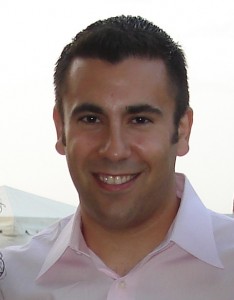08:00 | Conference Registration, Materials Pick-Up, Continental Breakfast and Networking |
|
Session Title: Conference Opening Session -- Biofabrication Field 2022 |
| |
08:45 |  | Conference Chair Welcome and Introduction by Conference Chairperson and an Overview of the Conference Topics, Speakers and Content
Lorenzo Moroni, Professor, Biofabrication for Regenerative Medicine, Maastricht University and Founder MERLN Institute for Technology-Inspired Regenerative Medicine, Netherlands
|
|
09:00 |  | Keynote Presentation Engineering Functional Human Tissue Using FRESH 3D Bioprinting
Adam Feinberg, CTO and Co-founder, FluidForm Inc., Professor of Biomedical Engineering, Carnegie Mellon University, United States of America
At FluidForm we are working to expand 3D bioprinting from a niche technology and into a versatile platform for fabricating functional human tissues with complex geometries and features ranging from the cellular to organ length scales. We are different because we are addressing limitations with current approaches with a specific focus on improving the structure and function of the engineered tissue constructs. To do this, we have developed novel biofabrication approaches focused on building extracellular matrix (ECM) scaffolds that mimic the structure and composition of the heart and other tissues and organs. Termed Freeform Reversible Embedding of Suspended Hydrogels (FRESH), we can 3D bioprint collagen, fibrin, decellularized ECM, growth factors, and a wide range of cell types into complex 3D architectures. This includes using FRESH to create small heart muscle constructs as a predictive model of cardiac electrophysiology all the way to large, organ-scale constructs based on patient-specific MRI scans that incorporate functional arteries and valves within full-size, whole hearts. Our focus at FluidForm is driving these applications into pharma and the clinic and extending these approaches to additional tissue and organ systems for in vitro disease modeling and in vivo regeneration. |
|
09:30 |  | Keynote Presentation Advanced 3D/4D Bioprinting for Complex Tissue Regeneration
Lijie Grace Zhang, Professor and Associate Dean for Research, The George Washington University, United States of America
As an emerging biomanufacturing technique, 3D bioprinting has begun to show great promise in tissue/organ replacement. In addition, 4D bioprinting is a highly innovative additive manufacturing process to fabricate pre-designed, self-assembly structures with the ability to transform from one state to another directly off the bioprinter. It not only enables precise control over multiple compositions, spatial distributions, and architectural accuracy/complexity, but also offers a unique dynamic variation under specific stimulation to spatiotemporally regulate cellular behaviors. The main objective of our research is to develop novel biologically inspired nano or smart inks and advanced 3D/4D bioprinting techniques to fabricate the next generation of complex tissue/organ constructs (such as vascularized tissue, cardiac tissue, and neural tissue). Our pioneering work in designing novel 4D bioprinting smart and nanomaterials has shown great promise for various biomedical applications. We have successfully designed a series of novel 4D bioprinted tissue structures with multi-responsive abilities, including internal stress-induced, solvent-responsive, thermo-responsive, and light-responsive tissue constructs. These smart constructs exhibit excellent biocompatibility and have significantly enhanced various stem cell functions when compared to traditional bioprinting constructs, thus promising for complex tissue/organ regeneration. |
|
10:00 |  Analytical and AI Guided Design of Bioinks and 3D Bioprinted Scaffolds Analytical and AI Guided Design of Bioinks and 3D Bioprinted Scaffolds
Dimitria Bonizol Camasao, Senior Application Scientist, Rheolution
Formulating functional bioinks and optimizing 3D bioprinted scaffolds often involve time-consuming and costly trial and error approaches. The use of dedicated analytical testing instruments and artificial intelligence (AI) algorithms may significantly accelerate these tasks. In this presentation, we will first introduce the ElastoSensTM Bio, a nondestructive testing instrument that measures the viscoelasticity of soft biomaterials. We will highlight how its features can bring value to the 3D and 4D bioprinting process, from the formulation of bioinks to the design of bioprinted scaffolds and their time evolution with or without cells. We will then focus on two published cases to exemplify how this technology and AI are currently helping researchers. In the first work developed by a team from University of Victoria (BC), the ElastoSensTM Bio was used to understand how the architecture of a scaffold produced through an extrusion-based printing affected its viscoelastic properties in terms of fiber size, porosity, pore shape, and bioink composition. In the second work, the testing instrument was used to build and validate an AI model able to predict the polymerization kinetics of a synthetic photocrosslinkable hydrogel (PEGDA). These unique and novel methodologies have the potential to accelerate research in tissue engineering and regenerative medicine, and their translation into clinical practices.
|
10:30 | Mid-Morning Coffee, Tea and Networking in the Exhibit Hall |
|
Session Title: Bioinks |
| |
11:30 | Designing Bioinks For 3D Tissue Bioprinting
Y. Shrike Zhang, Assistant Professor of Medicine, Harvard Medical School, Associate Bioengineer, Division of Engineering in Medicine, Brigham and Women’s Hospital, United States of America
Over the last decade, three-dimensional (3D) bioprinting has offered great versatility to fabricate biomimetic volumetric tissues that are both structurally and functionally relevant. It enables precise control over the composition, spatial distribution, and architecture of the bioprinted constructs, facilitating recapitulation of the delicate shapes and structures of target organs and tissues. In particular, the search for optimal bioink formulations has proven challenging as bioprinting materials must fulfill several, often contradictory requirements. In this talk, I will accordingly discuss our most recent efforts on developing cytocompatible, cell-instructive, and functional bioink formulations aiming at promoting our capacities in the fabrication of engineered tissue constructs. These bioinks, when rationally combined with a series of established or customized bioprinting strategies, not only improve their printability but also enhance the functions of the resulting tissues that are produced. |
12:00 | Decellularized Extracellular Matrix-based Bioinks for Printing Human Tissues
Jinah Jang, Associate Professor, Pohang University of Science And Technology (POSTECH), Korea South
Recent advances in biofabrication techniques have allowed for the fabrication of cardiac tissue models that are similar to the human heart in terms of their structure (e.g., volumetric scale and anatomy) and function (e.g., contractile and electrical properties). The importance of developing techniques for assessing the characteristics of 3D cardiac substitutes in real time without damaging their structures has also been emphasized. In particular, the heart has two primary mechanisms for transporting blood through the body: contractility and an electrical system based on intra- and extracellular calcium ion exchange. This talk will discuss how 3D cardiovascular tissue testing platform could be generated by integrating the concept of bioprinting-assisted tissue engineering and electrical sensing platforms. Combined with recent advances in human pluripotent stem cell technologies, printed human tissues could serve as an enabling platform for studying complex physiology in tissue and organ contexts of individuals. |
12:30 | Networking Lunch in the Exhibit Hall with Exhibitors and Conference Sponsors |
14:00 | Embedded 3D Printing of Dilute Particle Suspensions into Dense Complex Cardiac Fibers
Jeroen Rouwkema, Associate Professor, University of Twente, Netherlands
In order to fabricate functional organoids and microtissues, a high cell density is generally required. As such, the placement of cell suspensions in molds or microwells to allow for cell concentration by sedimentation, is a standard method for the production of organoids and microtissues. Even though molds offer some level of control over the shape of the resulting microtissue, this control is limited as microtissues tend to compact towards a sphere after sedimentation of the cells. 3D bioprinting offers better control over the shape of the resulting structure. However, when using extrusion 3D bioprinting, the self-assembly into organoids can be hampered due to low cell densities or the presence of bio-ink components which interfere with the self-assembly process. Even though the printing of dense cell suspensions without the addition of a biomaterial component in the ink has been reported, extruding dense cellular suspensions is challenging due to potential clogging of the printing nozzle and the exposure of the cells to high shear stresses. To circumvent these limitations, we have developed a simple and inexpensive embedded printing method to 3D print dense functional tissues using dilute (volume fraction < 10%) aqueous particle suspensions as an ink. These particles can be cells, spheroids, hydrogel beads, or combinations thereof. Using this approach, we have shown the formation of large functional and beating cardiac tissue fibers using human pluripotent stem cells. |
14:30 | Organoids and Complex Cell-based Architectures in Biofabrication and Volumetric Bioprinting
Riccardo Levato, Associate Professor in Translational Bioengineering and Biomaterials, University Medical Center Utrecht, Netherlands
The function of living tissues is intimately linked to their complex architectures. Advances in biofabrication technologies offer unprecedented opportunities to capture salient features of tissue composition and thus guide the maturation of engineered constructs into mimicking functionalities of native organs. In this lecture, the design of novel biofabrication strategies and printable biomaterials to enable the reconstitution of complex 3D structures with precise heterocellular, multi-material and hierarchical composition is discussed. Architectures designed to stimulate the native interaction between multiple (stem) cell types and self-assembled organoids are introduced, with a particular focus on applications in musculoskeletal regeneration and liver tissue engineering. Layerwise hydrogel extrusion and bioprinting, different additive manufacturing technologies, such as melt electrowriting of polymeric microfibers, ceramic plotting and digital light processing lithographic printing, can be combined to create composite, cell-laden constructs that enable integration between engineered hydrogels and hard tissue scaffolds to generate osteochondral grafts. Albeit powerful and versatile, this approach poses relevant limitations on the scalability and production of constructs having clinically relevant size, as well as on the generation of free-form and support free overhanging, porous structures, typically of native anatomy. To overcome these challenges, custom-designed light responsive hydrogels can be sculpted into cell-laden convoluted 3D structures within tens of second, via the development of layerless, volumetric bioprinting approaches inspired by visible light computed tomography. With such nozzle and shear stress-free, highly rapid cell processing approach a variety of hydrogel-based constructs can be assembled into hydrogel-based actuators for potential applications in soft robotics, or as platforms to enhance cell viability and maturation post-printing, including the shaping of large networks of hepatic epithelial organoids into defined 3D perfusable structures which exhibit biosynthetic and metabolic functions. Altogether, the combination of the different strengths of advanced bioprinting technologies offers new opportunities for the biofabrication of large, clinically-relevant multi-tissue constructs for regenerative medicine and tissue engineering. |
15:00 | Additive Manufacturing and Nanomaterials-based Platforms For Bone Modeling and Regeneration: Controlling Cell Fate by Combined Compositional and Morphological Cues
Gabriela Graziani, Assistant Professor, Politecnico di Milano, Italy
Bone is a hierarchical tissue, having complex morphology and composition. Hence, new approaches are needed to mimic its characteristics, to obtain bone models as well as for its regeneration. To fulfill these aims, a scaffold or models shall reproduce as closely as possible the composition of native bone, because mimicking the native tissue permits boosting bone regeneration, and because bone apatite has a critical role in modulating the behavior of both healthy and tumor cells in the models. At the same time, morphological characteristics (i.e. porosity, surface morphology and roughness) are fundamental to determine the mechanical behavior of the model and to provide cues to which cells can react and that influence their morphology, adhesion, proliferation and differentiation. Here we propose new routes for obtaining bone-mimetic materials, by combining additive manufacturing techniques (3d printing and electrospinning) and plasma-assisted deposition of nano-structured coatings (Ionized Jet Deposition). By these techniques, we reproduce the characteristics of the native tissue and guide its regeneration, exploiting biomimicry, morphological and compositional cues and we study their interactions with healthy (MSCs) and tumor (SAOS-2) cells, for applications in bone regeneration and modeling. |
15:30 | Afternoon Coffee and Tea Break in the Exhibit Hall |
16:00 |  | Keynote Presentation Bioprinting of Mammalian and Non-mammalian Cells for Applications in Medicine, Biotechnology and Space Exploration
Michael Gelinsky, Professor and Head, Center for Translational Bone, Joint and Soft Tissue Research, Faculty of Medicine, Technische Universität Dresden, Germany
Bioprinting has developed tremendously over the last 10-15 years. While the technology at the beginning has been investigated only for biomedical applications, utilizing human or other mammalian cells, in the meanwhile also non-mammalian cells like green algae, cyanobacteria or plant-derived cells have been bioprinted successfully. This opens new opportunities for applications in biotechnology. Both is also of interest for space flight: for long-term space exploratory missions and extra-terrestrial human settlements, e. g. on Moon or Mars, the astronauts must be able to treat health problems on site as a fast return to Earth is impossible. 3D bioprinting is a promising technology which might allow fabrication of tissue constructs like skin and bone with limited equipment and materials which mostly could be produced locally. Bioprinted constructs containing algae might be utilized for oxygen production and wastewater treatment. The presentation will give an overview about the work of the lab which has pioneered bioprinting of non-mammalian cells (“green bioprinting”) and which is closely connected to the European Space Agency ESA concerning the investigation of bioprinting for applications in space. |
|
16:45 |  Mechanobiology in 3D Bioprinting: Importance and Applications Mechanobiology in 3D Bioprinting: Importance and Applications
Zackary Wayne Tiedeman, Application Specialist, Optics11Life
3D printing mechanobiology / mechanical characterization of 3D structures / applications, including tissue regeneration.
|
17:15 |  | Keynote Presentation Biofabrication Technologies to Control Cell Fate
Lorenzo Moroni, Professor, Biofabrication for Regenerative Medicine, Maastricht University and Founder MERLN Institute for Technology-Inspired Regenerative Medicine, Netherlands
Organs are complex systems, comprised of different tissues, proteins, and cells, which communicate to orchestrate a myriad of functions in our bodies. Biofabrication technologies can be instrumental to replicate these structures towards the development of new therapies for tissue and organ repair, as well as for in vitro 3D models to better understand the morphogenetic biological processes that drive organogenesis. To construct tissues and organs, biofabrication strategies are being developed to impart spatiotemporal control over cell-cell and cell-extracellular matrix communication, often through control over cell and material deposition and placement. Here, we present some of our most recent advancements in biofabrication and biomaterial design that enabled the control of cell activity, moving towards enhanced tissue regeneration as well as the possibility to create more complex 3D in vitro models to study biological processes. These strategies can also find use in space, with a double purpose: on one side to use space as an accelerator of ageing on Earth, on the other side offering a possible set of emergency tools for the crew of deep space manned missions. |
|
17:45 | Network Reception with Beers -- Network and Engage with Colleagues and Exhibitors |
18:30 | Close of Day 1 of the Conference |






